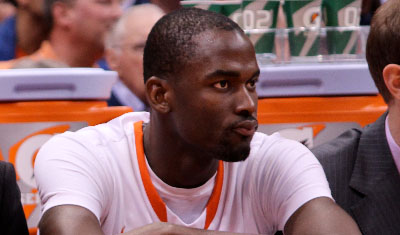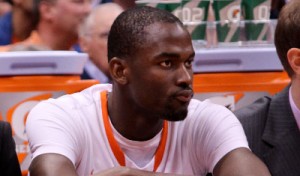
In the final part of a three-part series, Jeff Irvine breaks down Syracuse’s offseason needs on a player-by-player basis. This week, he takes a look at Syracuse’s centers.
Over the next four months, Syracuse’s returners from last year’s Final Four run will hit the weight room, mix it up in summer leagues, and spend countless hours alone in the gym shooting. It is the same ritual every year, and Syracuse has seen some remarkable transformations – and some not so much.
How can an Orange player make sure he’s ready come Midnight Madness? Fortunately, I’ve put together a list of historical role models they can look to for advice and some examples they would be wise to avoid.

Baye Moussa Keita
Keita looks to be on the path to a four-year “hustle guy” who never developed an offensive game. Syracuse’s front court will be very crowded next year, and while there is always room for a defensive specialist, Keita will need to learn some low-post moves if he is going to see the court frequently.
Player to emulate: Rick Jackson, summer of ’09. OK, so Jackson certainly had better post moves and saw more playing time than Keita in the ’10-’11 season, but like Keita, he often struggled catching the ball. Jackson made huge strides from his junior to senior year, upping his average from 9.7 ppg to 13.1 ppg at the same time as improving his defense and rebounding. We can’t expect Keita to have anything close to a conference player of the year season, but he should strive to make the leap that Jackson did, only from a lower starting point.
» Related: A look at Syracuse’s guards in the 2013-14 season
Example to avoid: Jeremy McNeil, summer of ’03. McNeil was a key defensive cog on Syracuse’s 2003 Championship team. He anchored the back of the press, which Coach Boeheim employed much more frequently back then, and averaged 2.9 blocks and 4.2 rebounds in less than 19 minutes per game. But the following season, freshman Daryl Watkins began to cut into his playing time, which decreased to 13 minutes per game, and his prolific defensive production returned to more normal levels.
Rakeem Christmas
Christmas came in as a 5-star recruit and McDonald’s All American. He has all the potential in the world but has yet to see it blossom. This is typical for big men, but with competition in the frontcourt, he needs his junior year to be a good one if he wants to retain his starting role.
Player to emulate: Daryl Watkins, summer of ’05. Watkins was also a highly rated center coming out of high school who struggled his first two years on the Hill. Watkins didn’t exactly have a breakout season his junior year, but he basically doubled his production from 3.7 ppg to 7.1 ppg, 3.3 rpg to 7.3 rpg and 1.4 bpg to 2.8 bpg. Much of this increase was due to the departure of Craig Forth, but if Christmas is able to double his production, I think most Orange fans would take it, no matter how it happens.
Example to avoid: Craig Forth, summer of ’03. Forth was a reasonably high rated center (#79 overall in the RSCI composite rankings) who struggled his first two seasons. It should be noted that he was good enough to be the center on a National Championship team his sophomore year, but Orange fans expected him to develop over his career. Sadly, he left Syracuse roughly the same player that arrived freshman year. This is what Christmas should avoid.
» Related: A look at the 2013-14 SU hoops team
DaJuan Coleman
It has been a recent theme for Syracuse basketball to have highly ranked center recruits disappoint in their freshman years. It takes big men longer to get used to the college game, the saying goes. This was certainly the case for Coleman. The 5-star McDonald’s All-American came to Syracuse as a starter but, due to injury and ineffectiveness, was a non-factor by the end of the year. To live up to his potential, he will need to get in better shape, improve his defense and add some finesse to his offensive moves.
Player to emulate: Fab Melo, summer of ’11. Melo’s freshman year was eerily similar to Coleman’s. He began the year as the starter but often looked lost and had issues with conditioning. Melo hit the gym in the offseason and lost about 30 pounds. He came back leaner and more agile. Before his suspension at the start of the NCAA tournament, he was the defensive anchor for a team that seemed destined for the Final Four. Coleman has more potential on the offensive end than Melo displayed in his sophomore season, but in order to utilize it he’s going to have to lose weight and become quicker, just like Melo did.
Example to avoid: Rakeem Christmas, summer of ’02. Christmas certainly did not have the weight issues that Coleman did his freshman year. But both players were former 5-star recruits and McDonald’s All American centers that failed to live up to the hype their freshman years. Although Coleman displayed some improvement this past season, he did not take the “leap” that many thought he might and ended up in Boeheim’s doghouse for long stretches of time. The Orange will have a crowded frontcourt next season, so if Coleman struggles to improve like Christmas did, he may find himself on the bench.
Chinoso Obokoh
Player to emulate: Baye Moussa Keita, summer of ’10. Obokoh will almost certainly redshirt because he will be third on the center depth chart (fourth if you count Coleman). But if he does suit up for the Orange next season, he could do worse than emulating Keita. At the start of the ’10-’11 campaign, Keita was stuck behind Melo and not expected to contribute. But he demonstrated his worth by playing good defense and rebounding, and he ultimately started 10 games. Obokoh is said to have a similar defensive and rebounding prowe
For more Syracuse coverage, Like our Facebook page and follow us @TheJuiceOnline.

